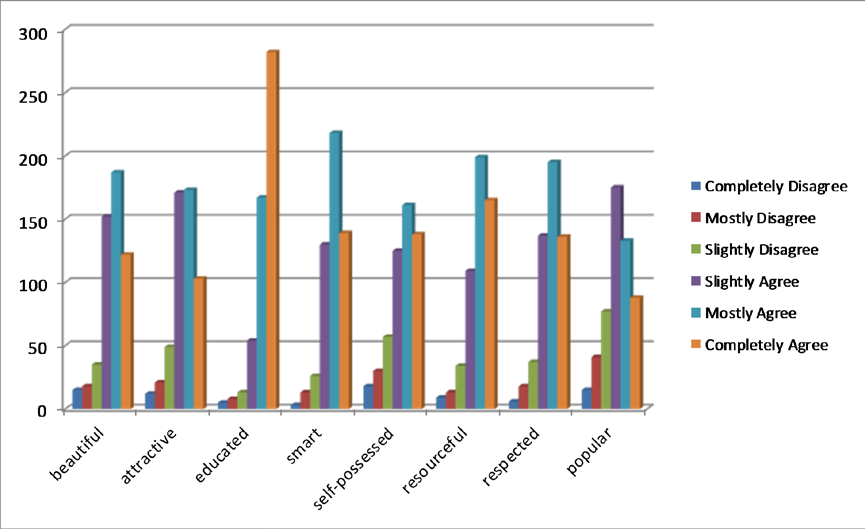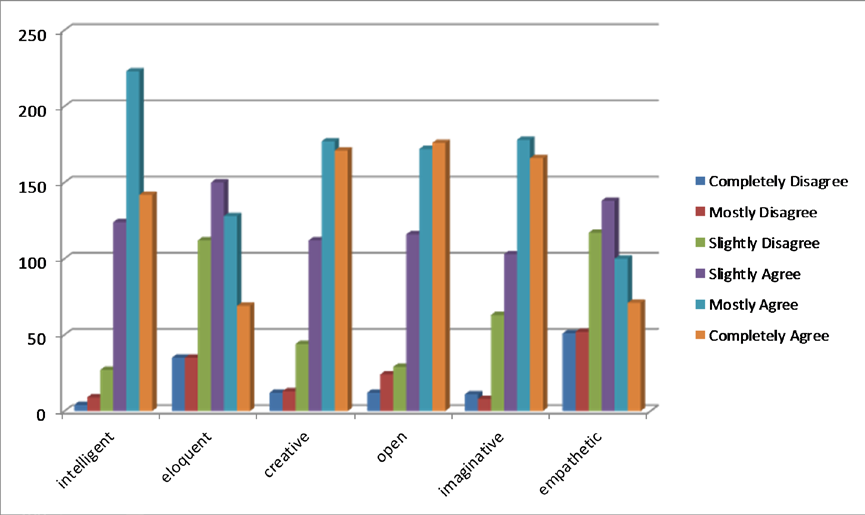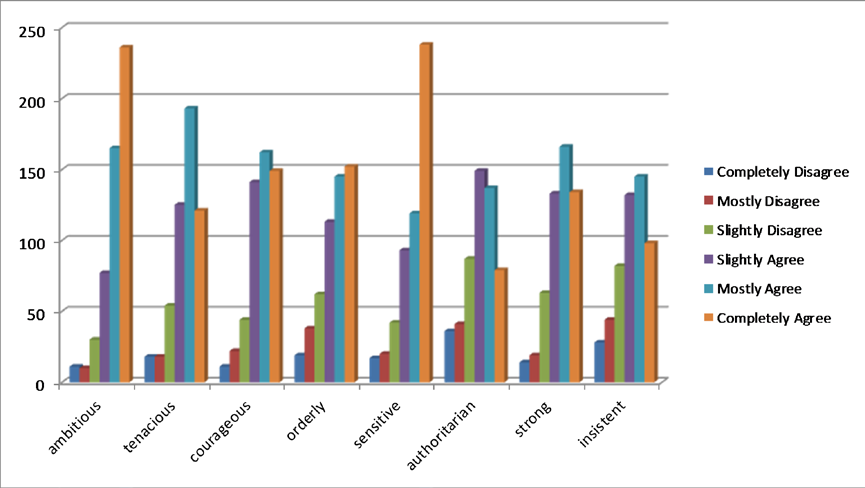Abstract
The human potential represents the highest point which can be reached by an individual in his/her development and requires the activation of all bio-psycho-physical resources. Among the factors that converge in the maximal development of the individual, it can be included the
Keywords: Self-imageself-esteempsychological portraitstudents’ feedbackPROFILES Project
Introduction
Each person has a mental image on its own person, a representation - at his psychic level - of its
individual particularities, built based on the convictions gathered in its subconscious mind, from the
experiences he has had, from the lived successes or failures, from certain faiths, from others’ reactions
and attitudes related to him/her.
The
appreciates its abilities, talents, physical aspect and social presence (Byrne, 1996). Its construction
begins very early during childhood and has a dynamic character, grows richer and becomes complex in
the course of the life. The
own image, to the subjective perception, strongly determined situationally, related to an isolated
behavior (Boncu, & Ceobanu, 2013).
The Psychological self-structure
The
realities: one subjective, interior - the
social self (me).
The psychanalyst theories (S. Freud, A. Freud, C. Rogers) consider that the
center of the human personality, which assures the dynamic and permanent integration of the
information on oneself, on the others and on the entire world, contributing to the shaping of the feeling
of identity, continuity and unity of one’s own existence (Ţuţu, 2008); self is a social product involved
in interpersonal relations. Rogers claims that there is a fundamental human need to have a positive
image both from others and from oneself (Purkey, 1988). The
the conscious reflection of one’s own being or identity, as an object separated from the others related to
the environment.
In the process of self-formation, three components are interpenetrated:
psychological or spiritual self and social self. The physical or corporeal self is the image on one’s
body’s internal environment, the image on one’s physical constitution, the affective experiences
connected to those mentioned above, the bio-physiological needs and the association to corresponding
value judgements (beautiful-ugly, pleasant-unpleasant, strong-weak, man-woman). This is the first self
which begins and develops during the ontogenesis. The
own internal psychical organization, the affective experiences related to that, the self-realization or
self-improvement needs which will to act, and the association with the following value judgements:
capable-incapable, talented-untalented, good-bad. The social self offers the image on one’s own place
and role in the society, the interiorized social value system, motives or status needs, social feelings
which will to interact and get integrated, and the association with value judgements such as:
appreciated-persecuted, integrated-marginalized, accomplished-frustrated, liked-hated (Golu, 2009).
M. Zlate (2002) speaks about the inner psychological structure of the self, including:
The subjective self, representing the individual’s self-image;
The reflected self, which is the self-image reflected in others, depending on their opinions;
The authentic self, different from the masks worn or the roles played by the individual and the
one that the individual could have if he/she were to actualize the unique being carried inside him;
The ideal self, what one wants to be or appear in order to answer expectations, to be accepted by the others and face the pressures exerted by the people around the individual. The ideal self is a projection of one’s self-image.The discrepancies between those facets of one’s self are correlated to various psychic vulnerabilities, negative psychological states, and physical discomfort.
The self-image
One of the main subjective forms of manifestation of the
interaction and inter-conditioning of external and internal factors, respectively of the following three
components: physical self-image, psychic self-image and social self-image (Golu, 2009). The self-
spiritual features) or the way a person perceives his/her
that others have about us, the way we are seen, appreciated and accepted by our fellows. The content of
one’s
we refer to our
the sum of the individual’s representations, ideas, beliefs about his/her own internalized personality.
The crystallization of one’s
place during one’s adolescence.
Depending on our perception, at a certain moment of our development, on what we wish to be or
what we could be, we can distinguish several hypostases of our
social and spiritual features at a certain moment. The dimensions of the actual self are:
physical self (what I think about my body);
cognitive self (what I think about the way I think, memorize etc.);
emotional self (what I think about my emotions and feelings);
social self (how I think others see me);
spiritual self (what I believe important and representing a value for me). Between the structure of the
the
context, and this image, once constituted, can influence, in its turn, the structure and the functioning of
one’s self (Craiovan, & Dîră, 2012). Maltz (1999) argues that all the actions, feelings and behaviours of
an individual always agree with his/her personal image, namely our
behaviours, which strongly calls for the construction of a realistic and correct
In the content of the
physical and psychic qualities we are aware of; social identity (name, age, residence, family,
profession, economic status etc.); way of understanding what we do, feel and think at a certain
moment, by relating that to certain value- and attitude-landmarks we are aware of as being
characteristic of ourselves; the representations we have about our position in society and about the roles
played in relevant life situations and circumstances; feelings to ourselves, to others and to the
significant events and situations we are or have been involved in; the physical and psychosocial area
bearing the mark of our will’s options, of our actions and of our personality (Craiovan & Dîră, 2012).
The
the passage and for the comparison of the individual’s own internal requirements (needs, desires,
aspirations and aims of his/her activity) and external requirements, conditioning the concrete way of
acting in each particular circumstance and situation (Golu, 2009). One’s self-image takes shape
progressively and changes continually throughout one’s life.
The Self-Esteem
The
al., 1995); it is the evaluative component of the
concept is very often correlated to professional success (Salmela-Aro & Nurmi, 2007; McCullough,
Ashbridge & Pegg, 1994; Chiu, 1990). The level of one’s
performances in all domains, people with a high
in command of themselves and succeed better, which later contributes to the consolidation of their
good opinion about themselves; a low level of
failures, which determines, in its turn, the shaping of a negative vision on one’s own person, the loss of
one’s
special importance in the human personality structuring process.
Methodology
The present research has aimed to identify the way that the
profession, detect the features making up the psychological portrait of the specialist in the area of
Sciences and the way the students project on the level of their
professional in the desired career (real self + future self = ideal self). The applied questionnaire aimed
to highlight how students perceive themselves, on a personal level, individually, and how a specialist in
the area is perceived by the students (physical and psychological portrait, but also his/her
character).The research sample consisted of 529 upper secondary students, aged between 15 and 19
years old, all of them being gathered in a group who answered to a
(
research being based on the implementation of a model of science instruction, taking into account the
effects of important variables of innovative and motivational learning environments on students’
outcome (Bolte, 2006).
Results and discussions
As result of the applied questionnaires, a series of features have been emphasized, offering the
possibility to group them into three categories:
-particular features concerning the self-image (beautiful, attractive, educated, smart, self-possessed,
resourceful, respected, popular);
-features related to the cognitive and emotional profile (intelligent, eloquent, creative, open,
imaginative, empathetic);
-features that refer to
courageous, orderly, sensitive, authoritarian, strong, insistent).
In terms of
and
level of the
levels (fig. 1).

In connection with the cognitive and emotional profile, the students’ stanceis oriented on high
features such as: intelligent, creative, open, imaginative, which shows that they know very well and
recognize in the structure of their personality important traits in terms of cognitive and emotional
development (fig. 2.).

Students consider that ambition, diligence and sensitivity are traits that define them best and those
represent the motivating factors on choosing the desired career. In opposition, authoritarian and
insistent features are found, receiving so a negative connotation in the students’ minds (fig. 3).

Conclusions
The career success is a target we all tend to. Any professional success acknowledged by individuals
and society can be considered an accomplishment. Obtaining professional success or success in life is
very much related to the
how well one’s
(2001) states that the individual has a paradox in front of him: although we have all the conditions to
know ourselves as well as possible, because nothing is closer to us (ontologically and epistemically)
than our own being, at the same time nothing is dearer to us than this being, which can distort our
perception in the favour of a positive image. The relation between the
and the
Regarding the presented study, the research has highlighted the fact that the individuals who had a
positive
features specific and necessary for such a career in this area, projecting themselves, on the level of their
ideal or desired self, within the boundaries of that profile, realizing an overlapping of their own
personality features over the researcher’s psychological, characterial and even physical profile. This
research is relevant because it highlights important aspects for the people in charge of training the
students for a career in the research area: the subjects have a psychical representation formed about the
specific features of the persons in the professional proposed sphere, and the identification at the mental
level with their “models” develops specific skills, opens clear horizons on choosing one’s career
(discovery of one’s vocation), motivationally supports one throughout the trajectory of the entire
specialized training. The students identified in the sphere of their own personality mainly those
desirable features that compose the researcher’s psychological and characterial portrait.
Acknowledgements
This work was funded through the Seventh Framework Programme “
Reflection Oriented Focus on Inquiry-based Learning and Education through Science” no. 5.2.2.1 -
SiS-2010-2.2.1, Grant Agreement No. 266589, Supporting and coordinating actions on innovative
methods in Science education: teacher training on inquiry based teaching methods on a large scale in
Europe. The support offered by the European Commission as well as the Community Research and
Development Information Service as responsible for the management of EU’s programmes in the fields
of research and innovation, through the project mentioned above, is gratefully acknowledged.
References
- Bolte, C. (2006). Evaluating Science Instruction by Using the Motivational Learning Environment Questionnaire. Proceedings of the Annual Meeting of the AERA. San Francisco, USA, April 2006.
- Boncu, Ș., & Ceobanu, C. (coord.) (2013). Psihosociologie școlară. Iași: Polirom.
- Byrne, B.M. (1996). Academic self-concept: Its structure, measurement and relation to academic achievement. In B.A. Bracken (ed.). Handbook of Self-Concept: Developmental, Social and Clinical Considerations. New-York: Wiley, 287-316.
- Chiu, L-H. (1990). The relationship of career goals and self-esteem among adolescents. Adolescence, 25(99), 593-607.
- Craiovan, M.P., & Dîră, M. (2012).Dinamica motivației profesionale în raport de structura și echilibrul imaginii de sine, în vol. Conferința Internațională Educație și Creativitate pentru o Societate Bazată pe Cunoaștere -Psihologie, București, 92-104.
- Golu, M. (2009). Fundamentele Psihologiei. vol II. București: Fundația România de Mâine.
- Iluț, P. (2001). Sinele și cunoașterea lui. Iași: Polirom.
- Maltz, M. (1999).Psiho-Cibernetica. Imaginea de sine –cheia spre o viață mai bună. Bucureşti: Curtea Veche. McCullough, P.M., Ashbridge, D., & Pegg, R. (1994). The effect of self-esteem, family structure, locus of control, and career goals on adolescent leadership. Adolescence, 29(115), 605-611.
- Purkey, W. (1988). An Overview of Self-Concept Theory for Counselors. ERIC Clearinghouse on Counseling and Personnel Services, Ann Arbor, Mich.
- Rosenberg, M., Schooler, C., Schoenbach, C., & Rosenberg, F. (1995). Global self-esteem and specific selfesteem: different concepts, different outcomes. American Sociological Review, 60, 141-156.
- Salmela-Aro, K., & Nurmi, J.-E. (2007). Self-esteem during university studies predicts career characteristics 10 years later. Journal of Vocational Behavior, 70(3), 463-477.
- Țuțu, M.C. (2008). Psihologia personalității. București: Fundația România de Mâine.
- Zlate, M. (2002). Eul și personalitatea. București: Trei.
Copyright information

This work is licensed under a Creative Commons Attribution-NonCommercial-NoDerivatives 4.0 International License.
About this article
Publication Date
04 October 2016
Article Doi
eBook ISBN
978-1-80296-014-3
Publisher
Future Academy
Volume
15
Print ISBN (optional)
-
Edition Number
1st Edition
Pages
1-1115
Subjects
Communication, communication studies, social interaction, moral purpose of education, social purpose of education
Cite this article as:
Santi, E. A., & Gorghiu, G. (2016). Self-Image as a Predictor of Success in Career - An Analysis in the Field of Sciences. In A. Sandu, T. Ciulei, & A. Frunza (Eds.), Logos Universality Mentality Education Novelty, vol 15. European Proceedings of Social and Behavioural Sciences (pp. 875-882). Future Academy. https://doi.org/10.15405/epsbs.2016.09.109

